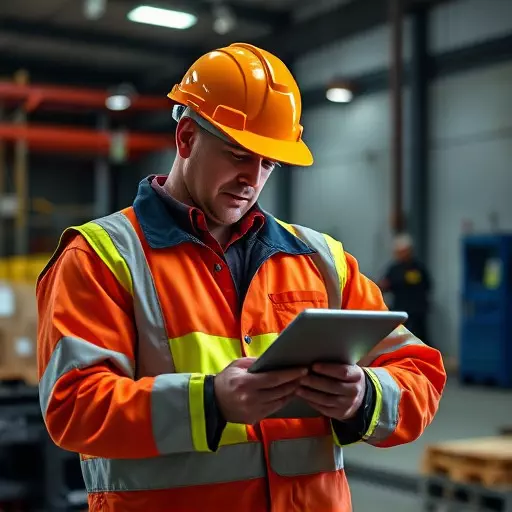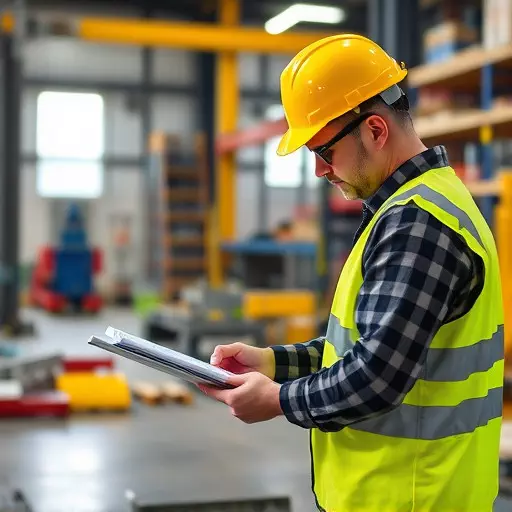Onsite EHS services are crucial for enhancing construction site safety through comprehensive workplace safety audits and meticulous hazard identification and risk assessments. These professionals regularly evaluate work environments, providing insights to implement tailored safety measures, reducing accidents, and fostering a culture of safety. By prioritizing onsite EHS services, construction sites can create healthier, more productive environments while ensuring regulatory compliance and protecting workers.
In today’s construction industry, ensuring worker safety is paramount. This article delves into crucial aspects of construction site safety evaluations, focusing on the integral role of Onsite EHS (Environmental Health and Safety) services. We explore how these professionals contribute to regulatory compliance and overall workplace well-being. Through a comprehensive guide, we detail the process of effective workplace safety audits, emphasizing key elements like hazard identification and risk assessment techniques. Additionally, real-world examples highlight the practical application of these essential tools in enhancing construction site safety.
- Understanding Onsite EHS Services and Their Role in Construction Safety
- – Definition and significance of Environmental Health and Safety (EHS) services on construction sites.
- – How these services contribute to overall workplace safety and regulatory compliance.
Understanding Onsite EHS Services and Their Role in Construction Safety

Onsite EHS (Environmental Health & Safety) services play a pivotal role in enhancing construction site safety by conducting thorough workplace safety audits. These professionals are equipped to identify potential hazards and conduct risk assessments, which are essential components of any comprehensive safety program. By regularly evaluating work environments, they ensure compliance with relevant regulations and industry standards. This proactive approach not only mitigates risks but also fosters a culture of safety among workers.
Through detailed inspections and meticulous documentation, onsite EHS services pinpoint areas that require improvement. They offer practical solutions and guidance to rectify identified hazards, ensuring the well-being of all personnel on the construction site. Their expertise in hazard identification and risk assessment is invaluable, as it enables project managers to implement effective safety measures tailored to specific jobsite conditions.
– Definition and significance of Environmental Health and Safety (EHS) services on construction sites.

Environmental Health and Safety (EHS) services on construction sites play a pivotal role in ensuring the well-being of workers and compliance with regulatory standards. These services encompass a comprehensive range of practices aimed at identifying, mitigating, and preventing potential hazards that are ubiquitous in the construction industry. By integrating onsite EHS services, construction companies can significantly enhance workplace safety.
The process typically involves thorough workplace safety audits, where experts meticulously assess the site to identify risks and unsafe conditions. This includes hazard identification and risk assessment, which are fundamental steps in managing potential dangers. Through these assessments, construction managers gain valuable insights into areas requiring improvement, enabling them to implement effective control measures. By prioritizing EHS services, construction sites can foster a culture of safety, reducing accidents, and ensuring a healthier, more productive work environment.
– How these services contribute to overall workplace safety and regulatory compliance.

Construction sites are inherently high-risk environments, making comprehensive safety evaluations crucial. Onsite EHS services play a pivotal role in enhancing workplace safety and ensuring regulatory compliance. These professionals conduct thorough workplace safety audits, meticulously scrutinizing every aspect of the construction site, from equipment maintenance to worker practices. By employing advanced hazard identification techniques, they pinpoint potential risks that might be overlooked by untrained eyes. This process involves assessing physical hazards, chemical exposures, and ergonomic factors, among others.
Through risk assessment, onsite EHS services quantify the likelihood and severity of identified hazards, enabling proactive measures to mitigate dangers. Regular evaluations not only protect workers from injuries and illnesses but also safeguard employers from hefty fines and legal repercussions associated with safety violations. By integrating these services into construction project management, companies demonstrate a commitment to creating a safer, more compliant work environment.


